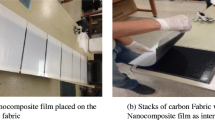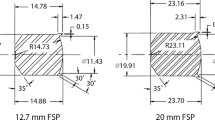Abstract
The material model for a multi-walled carbon nanotube (MWCNT) reinforced poly-vinyl-ester-epoxy matrix composite material (carbon nanotube reinforced composite mats, in the following) developed in our recent work (M. Grujicic et al. submitted), has been used in the present work within a transient non-linear dynamics analysis to carry out design optimization of a hybrid polymer-matrix composite armor for the ballistic performance with respect to the impact by a fragment simulating projectile (FSP). The armor is constructed from E-glass continuous-fiber poly-vinyl-ester-epoxy matrix composite laminas interlaced with the carbon nanotube reinforced composite mats. Different designs of the hybrid armor are obtained by varying the location and the thickness of the carbon nanotube reinforced composite mats. The results obtained indicate that at a fixed thickness of the armor, both the position and the thickness of the carbon nanotube reinforced composite mats affect the ballistic performance of the armor. Specifically, it is found that the best performance of the armor is obtained when thicker carbon nanotube reinforced composite mats are placed near the front armor face, the face which is struck by the projectile. The results obtained are rationalized using an analysis of the elastic wave reflection and transmission behavior at the lamina/met and laminate/air interfaces.






Similar content being viewed by others
References
U.S. Military Department of Defense Specification, MIL-A-12560H95, July (1991)
Williams K, Poon K (2000) A numerical analysis of the effect of surrogate anti-tank mine blasts on the M113. DREV TM-2000-007, DRDC, Valcartier, Quebec, Canada
Grujicic M, Pandurangan B, Koudela KL, Cheeseman BA (2006) A computational analysis of the ballistic performance of light-weight hybrid-composite armor. Appl Surf Sci (accepted for publication)
Zhu J, Kim J, Peng H, Margrave JL, Khabashesku VN, Barrera EV (2003) Nano Lett 3:1107
Ashrafi B, Hubert P (2006) Compos Sci Technol 66:387
Lourie O, Wagner HD (1998) J Mater Res 13:2418
Walters DA, Ericson LM, Casavant MJ, Liu J, Colbert DT, Smith KA, Smalley RE (1999) Appl Phys Lett 74:3803
Andrews R, Jacques D, Rao AM, Rantell T, Derbyshire F, Chen Y, Chen J, Haddon RC (1999) Appl Phys Lett 75:1329
Mamedov AA, Kotov NA, Prato M, Guldi DM, Wicksted JP, Hirsch A (2002) Nat Mater 1:190
Salvetat JP, Briggs GAD, Bonard JM, Bacsa RR, Kulik AJ, Stockli T, Burnham NA, Forro L (1999) Phys Rev Lett 82:944
Chen J, Rao AM, Lyuksyutov S, Itkis ME, Hamon MA, Hu H, Cohn RW, Eklund PC, Colbert DT, Smalley RE, Haddon RC (2001) J Phys Chem B 105:2525
Frankland SJV, Caglar A, Brenner DW, Griebel M (2002) J Phys Chem B 106:3046
Watts PCP, Hsu WK, Chen GZ, Fray DJ, Kroto HW, Walton DRM (2001) J Mater Chem 11:2482
Thess A (1996) Science 273:483
Kis A, Csanyi G, Salvetat J-P, Lee T-N, Couteau E, Kulik AJ, Benoit W, Brugger J, Forro L (2004) Nat Mater 3:153
Dalton AB, Collins S, Munoz E, Razal JM, Ebron VH, Ferraris JP, Coleman JN, Kim BG, Baughman RH (2003) Nature 423:703
Zhu HW, Xu CL, Wu DH, Wei BQ, Vajtai RR, Ajayan PM (2002) Science 296:884
Grujicic M, Cao G, Roy WN (2004) Appl Surf Sci 227:349
Grujicic M, Cao G, Roy WN (2004) J Mater Sci 39:2315
AUTODYN-2D and 3D, Version 6.1 (2006) User Documentation, Century Dynamics Inc
Grujicic M, Pandurangan B, Cheeseman BA (2006) Shock Vib 13:41
Johnson GR, Cook WH (1983) A constitutive model and data for metals subjected to large strains, high strain rates and high temperatures. Proceedings of the 7th international symposium on ballistics
Clegg RA, Hayhurst CJ, Leahy JG, Deutekon M (1999) Application of a coupled anisotropic material model to high velocity impact response of composite textile armor. 18th International symposium on ballistics, San Antonio, Texas, 15–19 November, 1999, pp 791–798
Anderson CE, Cox PA, Johnson GR, Maudlin PJ (1994) Comput Mech 15:201
Gruneisen (1926) Handbuch der Physik. Springer-Verlag, Berlin, p 10
Riedel W, White DM, Clegg RA and Harwick W (2003) Advanced material damage models for numerical simulation codes, EMI-Report No. I 75/03, ESA CR (P) 4379
Phadke MS (1989) Quality engineering using robust design. Prentice Hall, Englewood Cliffs, NJ
Montgomery DC (2002) Design and analysis of experiments. Wiley Publishers
Ross PJ (1996) Taguchi techniques for quality engineering: loss function, orthogonal experiments, parameter and tolerance design, 2nd edn. McGraw-Hill, New York
Kardos JL (1985) Pure Appl Chem 57:1651
Acknowledgements
The material presented in this paper is based on work supported by the Naval Research Office ender the Grant Number N00014-05-1-0844, by the U.S. Army/Clemson University Cooperative Agreement Number W911NF-04-2-0024 and by the U.S. Army Grant Number DAAD19-01-1-0661. The authors are indebted to Dr. Tom Juska of the Naval Research Laboratory and to Drs. Walter Roy, Bryan Cheeseman and Fred Stanton from the Army Research Laboratory.
Author information
Authors and Affiliations
Corresponding author
Rights and permissions
About this article
Cite this article
Grujicic, M., Pandurangan, B., Angstadt, D.C. et al. Ballistic-performance optimization of a hybrid carbon-nanotube/E-glass reinforced poly-vinyl-ester-epoxy-matrix composite armor. J Mater Sci 42, 5347–5359 (2007). https://doi.org/10.1007/s10853-006-0959-x
Received:
Accepted:
Published:
Issue Date:
DOI: https://doi.org/10.1007/s10853-006-0959-x




